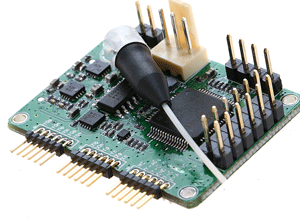


 Annex
Annex
Introduction
Rofea’ modulator bias controller is specially designed for Mach- Zehnder modulators to ensure a stable operation state in various operating environments. Based on its entirely digitized signal processing method, the controller can provide ultra-stable performance. The controller injects a low frequency, low amplitude dither signal together with bias voltage into the modulator. It keeps reading the modulator's output and determines the condition of the bias voltage and the related error. A new bias voltage will be applied afterward according to the previous measurement. In this way, the modulator is ensured to work under a proper bias voltage.Feature
•Bias voltage control on Peak/Null/Q+/Q−
•Bias voltage control on an arbitrary point
•Ultra precise control:
1. 50dB maximum extinction ratio on Null mode
2. ±0.5◦ accuracy on Q+ and Q− modes
•Low dither amplitude:
1. 0.1% Vπ at NULL mode and PEAK mode
2. 2% Vπ at Q+ mode and Q− mode
•High stability: with fully digital implementation
•Low profile: 40mm(W) × 30mm(D) × 10mm(H)
• Easy to use:
1. Manual operation with a mini jumper
2. Flexible OEM operations through MCU UART2
•Two different modes to provide bias voltage:
a.Automatic bias control
b.User-defined bias voltage
Application
• LiNbO3 and other MZ modulators
• Digital NRZ, RZ
• Pulse applications
• Brillouin scattering system and other optical sensors
• CATV Transmitter
1 The highest extinction ratio depends on and cannot exceed the modulator maximum extinction ratio.
2 UART operation is only available on some version of the controller.
Specifications:
|
Parameter |
Min |
Typ |
Max |
Unit |
Conditions |
|
Control Performance |
|||||
|
Extinction ratio |
|
MER 1 |
50 |
dB |
|
|
CSO2 |
−55 |
−65 |
−70 |
dBc |
Dither amplitude: 2%Vπ |
|
Stabilization time |
|
4 |
|
s |
Tracking points: Null & Peak |
|
10 |
Tracking points: Q+ & Q- |
||||
|
Electrical |
|||||
|
Positive power voltage |
+14.5 |
+15 |
+15.5 |
V |
|
|
Positive power current |
20 |
|
30 |
mA |
|
|
Negative power voltage |
-15.5 |
-15 |
-14.5 |
V |
|
|
Negative power current |
2 |
|
4 |
mA |
|
|
Output voltage range |
-9.57 |
|
+9.85 |
V |
|
|
Output voltage precision |
|
346 |
|
µV |
|
|
Dither frequency |
999.95 |
1000 |
1000.05 |
Hz |
Version: 1kHz dither signal |
|
Dither amplitude |
|
0.1%Vπ |
|
V |
Tracking points: Null & Peak |
|
2%Vπ |
Tracking points: Q+ & Q- |
||||
|
Optical |
|||||
|
Input optical power3 |
-30 |
|
-5 |
dBm |
|
|
Input wavelength |
780 |
|
2000 |
nm |
|
1 MER refers to Modulator Extinction Ratio. The extinction ratio achieved is typically the extinction ratio of the modulator specified in the modulator datasheet.
2 CSO refers to composite second order. The linear quality of RF signal, modulators, and receivers shall be ensured. In addition, the system CSO readings may vary when running at different RF frequencies.
3 Please be noted that input optical power does not correspond to the optical power at the selected bias point. It refers to the maximum optical power that the modulator can export to the controller when bias voltage ranges from −Vπ to +Vπ.